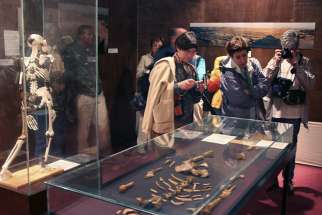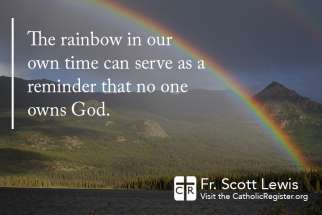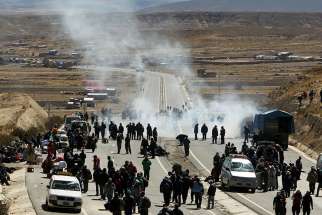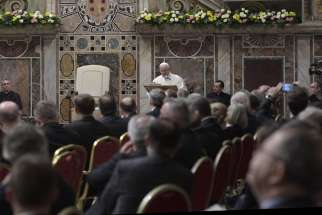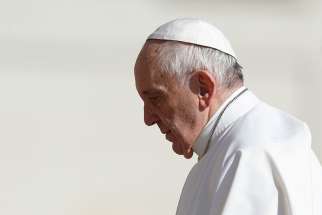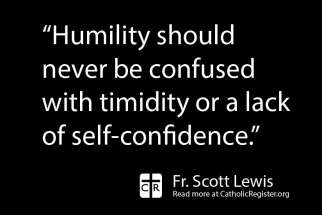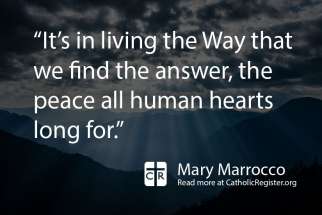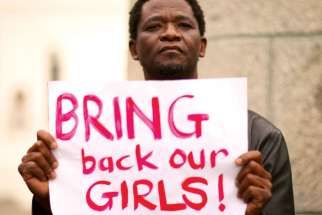VATICAN CITY - As a follow-up to a 2013 symposium on the origin and evolution of humans, the Pontifical Academy of Sciences held a workshop discussing the latest discoveries about humanity's earliest ancestors -- where they lived and what they may have looked like millions of years ago.
Fr. Scott Lewis: God never excludes or gives up on anyone
Comment: It's through giving that our humanity is fully realized
VATICAN CITY – Europe must recover the memories and lessons of past tragedies in order to confront the challenges Europeans face today that seek to divide rather than unite humanity, Pope Francis said.
Sincere humanity has shaped Francis’ four years as Pope
VATICAN CITY – Rather than a weakness, Pope Francis' humanity – and his acknowledgment of it – has been a source of strength and impact during the four years of his pontificate, said Vatican's press office director.
Be comfortable in your own skin
22nd Sunday in Ordinary Time (Year C) Aug. 28 (Sirach 3:17-20, 28-29; Psalm 68; Hebrews 12:18-19, 22-24a; Luke 14:1, 7-14)
The virtue of humility gets a lot of bad press. It is often seen as an invitation to be treated as a doormat or as a lack of self-esteem. Humility can also be used to oppress people by “keeping them in their place.”
God is found in being present to each other
Recently I received, on the same day, articles from three different sources. One was about the 219 girls captured by Boko Haram who are still missing. The second, about “way more” than 1,200 aboriginal Canadian women missing or murdered. And the third, about 4,472 baby girls “unaccounted for” in Canada over the past 20 years, referring to female fetuses aborted in favour of male children.
We all have a role in God’s divine plan
Ascension of the Lord (Year C) May 8 (Acts 1:1-11; Psalm 47; Ephesians 1:17-23; Luke 24:46-53)
What is it like to ascend to the heavens? The sight of astronauts floating effortlessly around a space station or outside on a repair mission has become so commonplace that it doesn’t even elicit much comment. When we read the account of the Ascension in Acts, it seems to pale in comparison to the accomplishments of our own time.
Music takes Steve Bell from the big house to God’s house
Catholic higher education at the service of humanity
There is a perception, which has widened in the last 40 years, that Catholic higher education is no longer compatible with the modern university. A recent article in the Chronicle of Higher Education charged denominational colleges and universities should be refused accreditation for “systematically undermining… skeptical and unfettered inquiry” and “the primacy of reason.”
There’s no humanity without God, and no God without humanity
While the Lord is experienced in positive and negative ways, He is always love
A man’s heart cries out. For years, Jeff has tried to follow God, but hasn’t found his dearest dream: a woman he could love and be loved by, who wants God as the foundation of their marriage. Why the rejection? Isn’t God love? Isn’t this cruel?
Other Christians have experienced God as silent, steel, remote, distant, stingy, unyielding, ruthless, “the great vivisectionist.” At other times we know Him as tenderness, gentleness, beauty, life, creativity, kindness, compassion, intimate presence. Who is He really?
“You’ve got to learn to wrestle with God!” Our model is Jacob, who spent the night wrestling someone (Genesis 32). At dawn, Jacob’s adversary wounded him, blessed him and gave him his name, Israel. In the struggle with God, we may discover our true name, and our real self — wounds and all. At least by wrestling, we dare to show what’s going on inside us.
The Church helps us wrestle by giving us Lent. Ash Wednesday, Feb. 13, shows Lent is physical as well as spiritual: we mark our bodies with a reminder of mortality, we take on spiritual disciplines that affect us in the flesh. It’s total; we use everything we have and are to communicate with God.
In its early centuries, the Church wrestled with many questions about God, including this: how could there be any true communication, any meeting-point, between the real God and us? Wouldn’t humans be lost in God’s vastness or God somehow be made less by being grasped?
Wrestlers get so intertwined that they look almost like one person. They feel each other’s strengths and weaknesses, bodies and spirits. Could it be like that between us and God? Could Jeff, by not giving up but coming back and back with his question, be in true communication with the living God?
Among us humans, communication happens through electronic forms known as “social media.” These involve much self-presentation: showing photos and videos of ourselves, our friends, food or pets or silly moments; we write bits of news about what we were thinking just before breakfast; we put together montages revealing our thoughts and desires, without discrimination, the painful and the odd, the beautiful and delightful. It allows for creativity as well as self-exposure.
It’s as though people are holding their faces up to an invisible mirror. Through it, they see their own reflection and invite others to see it too. Like the ordinary, visible mirror, this sort of self-study can be destructive, as in the myth of Narcissus: the youth whose handsomeness broke many hearts. One day he saw his reflection in a still pool. He had nothing to prepare him or help him understand it. He fell in love with his own beauty, but died because he couldn’t touch or fulfill his love of the image he saw.
Underneath the Narcissus story, and behind the passion for electronic self-exposure, lie understandable human desires. We want to see and know ourselves, to contemplate our image — though we can’t see our own faces. We want to show ourselves to others, be reflected back, have someone find us beautiful and interesting and love us. We want to dig inside ourselves and find creative ways to bring forth what we discover inside. We want these things even though we fear they’re impossible, since we also experience ourselves as ugly, unimportant and unlovable.
These desires reflect a divine movement: God beckoning, reflecting back our true image, the image of beauty He called forth in us. God “bending the heavens,” as the psalm says, to show us we’re beloved. God doing the impossible to call us to this truth of ourselves, beyond the scars of sin — our own and others.
Deepest, truest, wildest in us is our desire for God, without whom we can never find rest. Our need to communicate, to be seen, can’t be fully satisfied by any human communication, by electronic self-disclosure or song and dance or feasting, by studying ourselves or even by loving one another — though all these things may, and some must, bring us closer.
That’s why human communication always involves frustration, even when it’s exhilarating. Whatever we seek is never truly found except in God. And He’s completely beyond us, though nearer to us than our fingernails to our fingers.
How could there be a meeting-point between God the Creator and us His creatures? Only in the one who in Himself unites human with divine. There’s no humanity without God — and because of Christ, there’s no God without humanity.
That’s the intimacy we seek, whether through electronic media or dances in the village square. It’s what we invite through our Lenten spiritual practices. They prepare us to receive the fullness of God’s love without any shadow or cruelty or pain.
No wonder we experience Him in negative as well as positive ways: thirst and hunger, pain and longing, cruelty and ruthlessness. Gentleness, kindness, wonder, delight. And love.
He’s in everything, even in Jeff’s long longing.
Supreme Court reserves judgment on humanity of unborn cases
OTTAWA - The Supreme Court of Canada has reserved judgment in two cases that involve mothers who abandoned their babies because they believed they were born dead.
On Oct. 10, the court heard the case of Ivana Levkovic who left the corpse of her baby girl on her apartment balcony wrapped in blankets inside a bag. The next day, Canada's highest court heard the case of A.D.H., who gave birth to a baby boy in a toilet at a Wal-Mart in Saskatchewan. Thinking he was dead, she fled the store and left him behind. The baby was discovered and resuscitated.
Both women were acquitted by their respective trial judges. Levkovic told the court she had fallen down, precipitating labour and the baby was born dead. Because the body was so decomposed, the coroner could not tell whether the infant girl, who was near full term, died before birth, so the judge acquitted her.
A.D.H. claimed to be surprised to discover she was pregnant and shocked by the delivery, which took place during a 14-minute visit to the store. Her case hinges on whether one's subjective belief — i.e. that the baby was dead — should override an objective standard of what a reasonable person would do under the circumstances.
Both cases touch on the contentious issue of when a child becomes a human being, since the Criminal Code has sections that seem to contradict each other. MP Stephen Woodworth's Motion 312, recently defeated in the House of Commons, sought to address the definition in Section 223.1 of the code which says the unborn child does not become a human being until the process of birth is completed.
Levkovic was charged under section 243 of the Criminal Code which makes it illegal to conceal a dead child's body whether the "child died before, during or after birth," while A.D.H. was acquitted of child abandonment.
On Oct. 10, Chief Justice Beverley McLachlan wouldn't use the word "child" since the terminology is "under contention." At one point she referred to the unborn child as the "thing" or "object" expelled from the mother's body during the process of delivery.
Attorney Jill Copeland and Delmar Doucette argued the law is too vague and creates too great a "zone of risk" for women who may not know whether they might have violated it simply by having a miscarriage. They also argued the section violates the security of the person and the rights of women to make decisions concerning a failed pregnancy as well as violates her privacy rights by forcing her to disclose that pregnancy. They wanted Levkovic's acquittal recognized.
The Criminal Lawyers' Association of Ontario intervened in the case, arguing that section 243 was criminalizing behaviour that is not a crime.
"The act of having a miscarriage is not illegal," attorney Marie Henein told the court. The right of a woman to control her own body is constitutionally protected and sacrosanct, she said, noting societal norms see these rights as settled.
Many of the questions from the bench concerned issues of viability and how likely an unborn child would be able to live outside the womb.
Arguing for the Attorney General of Ontario, Jamie Klukach argued the section has an investigatory purpose.
"The state has an interest in seeing the child and investigating" the cause of death, Klukach said.
Societal values on proper respect to the dead also apply, she said, noting that proper burial and the duty of dignity to human remains have a long common law history. So does the concept of the sanctity of life and the preservation of life. The state must be notified about deaths, she said, and a body "cannot be concealed at the whim of an individual."
Section 243 compels a woman to disclose the fact of the birth, she said. The conduct it proscribes is the intentional concealment and disposal of a body because it could involve the destruction of evidence, akin to the obstruction of justice.
Intervening on behalf of the Attorney General of Canada, Robert Frater said the law was not too vague, nor did it create too wide a zone of risk.
"A woman has to ask herself, 'If I dispose of a dead body and someone finds it might someone conclude that a crime has taken place?' ” Frater said.


